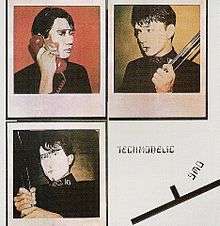Technodelic
| Technodelic | ||||
|---|---|---|---|---|
|
| ||||
| Studio album by Yellow Magic Orchestra | ||||
| Released | November 21, 1981 | |||
| Recorded | March 21 – October 13, 1981 | |||
| Studio | Alfa Studio "A", Shibaura, Minato, Tokyo | |||
| Genre | ||||
| Length | 43:29 | |||
| Label | Alfa | |||
| Producer |
| |||
| Yellow Magic Orchestra chronology | ||||
| ||||
| Singles from Technodelic | ||||
|
||||
| Alternative cover | ||||
 The first press (1981) |
||||
| Professional ratings | |
|---|---|
| Review scores | |
| Source | Rating |
| AllMusic | |
Technodelic is the fifth studio album by Yellow Magic Orchestra, released in 1981. The album is notable for its experimental and heavy use of samplers which were not commonly used until the mid-to-late 1980s, resulting in a more minimalist sound compared to their previous work.
It is considered the first released album to feature mostly samples and loops, influencing the heavy use of sampling and looping in popular music.[2] Yellow Magic Orchestra's approach to sampling music was a precursor to the contemporary approach of constructing music by cutting fragments of sounds and looping them using computer technology.[3]
Production
Most of the sampling was made with an LMD-649 - a hand-made sampler developed by Toshiba-EMI engineer Kenji Murata, and a much cheaper alternative to the Linn LM-1 drum machine and Fairlight CMI sampling synthesizer available at the time. Notable samples used include Indonesian kecak chanting (Neue Tanz), gamelan and short looped vocals ("paa", "fuku", "chiki") for percussion in "Seoul Music," and the final two tracks feature factory noises. The album also features use of speech through a two-way radio, a prepared piano, Prophet-5 synthesizers, and a TR-808 drum machine. In another departure from previous albums, Haruomi Hosono has a more prominent role playing the bass guitar as opposed to playing bass lines on synthesizers (this trend appears again on the album Service).
As with many of YMO's releases, song titles are printed in both Japanese and English. For "Seoul Music", the kanji "京城" are used, referring to Gyeongseong (경성; known as Keijou in Japan), the name of Seoul when Korea was under Japanese rule. "灯" simply translates to "Light". "Neue Tanz" is German for "New Dance", while "Taisō" is Japanese for "gymnastics" or "calisthenics".
Track listing
| Side one | ||||
|---|---|---|---|---|
| No. | Title | Lyrics | Music | Length |
| 1. | "Pure Jam" (ジャム; "Jam") | Yukihiro Takahashi Peter Barakan | Takahashi | 4:30 |
| 2. | "Neue Tanz" (新舞踊; "Shin buyou") | Yellow Magic Orchestra | YMO | 4:58 |
| 3. | "Stairs" (階段; "Kaidan") | Takahashi, Barakan | Takahashi | 4:14 |
| 4. | "Seoul Music" (京城音楽; "Keijou ongaku") | Ryuichi Sakamoto, Takahashi, Barakan | Sakamoto, Takahashi | 4:46 |
| 5. | "Light in Darkness" (灯; "Tomoshibi") | Takahashi, Sakamoto | 3:40 | |
| Side two | ||||
|---|---|---|---|---|
| No. | Title | Lyrics | Music | Length |
| 1. | "Taiso" (体操; "Taisō") | YMO | YMO | 4:21 |
| 2. | "Gradated Grey" ( | Haruomi Hosono | Hosono | 5:33 |
| 3. | "Key" (手掛かり; "Tegakari") | Hosono, Takahashi, Barakan | Hosono, Takahashi | 4:32 |
| 4. | "Prologue" (前奏; "Zensou") | Sakamoto | 2:31 | |
| 5. | "Epilogue" (後奏; "Kousou") | Sakamoto | 4:21 | |
Personnel
 |
"Pure Jam"
Sample of electro track "Pure Jam" from the album Technodelic, demonstrating a more minimalistic approach. "Seoul Music"
|
| Problems playing these files? See media help. | |
- Yellow Magic Orchestra - Arrangements, Electronics, Sampler, Mixing engineers, Producers
- Haruomi Hosono - Bass, Synth Bass, Keyboards, Vocals
- Ryuichi Sakamoto - Keyboards, Vocals
- Yukihiro Takahashi - Vocals, Drums, Electronic drums
- Guest musicians
- Hideki Matsutake - Technical assistance
- Takeshii Fujii & Akihiko Yamazoe - Equipment
- Peter Barakan - Lyrics, Transceiver Voice on "Pure Jam"
- Staff
- Shōrō Kawazoe - Executive Producer
- Mitsuo Koike - Recording & Mixing engineer
- Yoshifumi Īo - Assistant Engineer
- Hiroshi Yuasa (JVC Cutting Center) - Mastering engineer
- Kazusuke Obi - A&R Coordinator
- Yōichi Itō & Hiroshi Ōkura - Management
- Plan-New Werk - Creative Services
- Masayoshi Sukita - Art director, Photography
Notes
- ↑ AllMusic review
- ↑ Carter, Monica (June 30, 2011). "It's Easy When You're Big In Japan: Yellow Magic Orchestra at The Hollywood Bowl". The Vinyl District. Retrieved 22 July 2011.
- ↑ Condry, Ian (2006). Hip-hop Japan: rap and the paths of cultural globalization. Duke University Press. p. 60. ISBN 0-8223-3892-0. Retrieved 12 June 2011.
References
- Technodelic at AllMusic. Retrieved 2011-06-19.